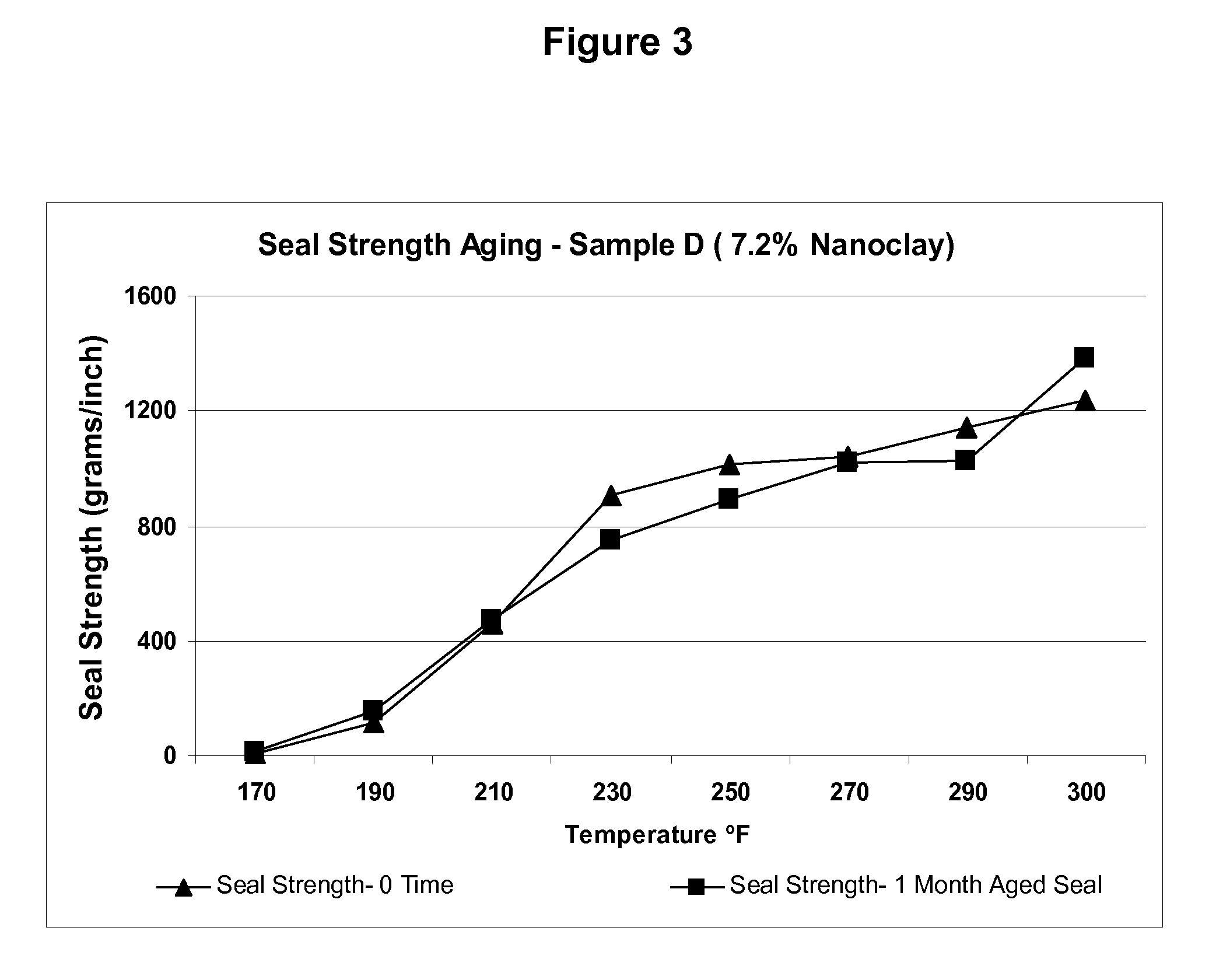Peelable Films Containing Nano Particles
a nano-particle, peelable technology, applied in the field of peelable films, can solve the problems of affecting the peeling effect, so as to reduce the interaction of polymer and polymer, reduce the peeling effect, and maintain the peeling
- Summary
- Abstract
- Description
- Claims
- Application Information
AI Technical Summary
Benefits of technology
Problems solved by technology
Method used
Image
Examples
example 1
Effect of Percent Nanoclay on Peel Seal Strength
[0084]Two test films, Sample A and Sample B, were prepared having a peelable sealant layer and one additional layer. The peelable sealant layer of the test films was made by blending a base resin with nanoclay concentrate. The base resin consisted of an 18% vinyl acetate, 1.5 melt index (MI) EVA resin available from DuPont, having the tradename Elvax® 3169Z. The nanoclay concentrate consisted of 60% by weight nanoclay dispersed in a base polymer, available from PolyOne, having the tradename X150-258-102-3. The composition of the test films further contained 6% by weight of an additive mixture containing 5% by weight slip additive and 20% by weight antiblock additive, available from Polyfil, having the tradename POLYFIL® FSABC0520. The test films were formulated such that one had 6% by weight nanoclay in the sealant layer and the other had 9% by weight nanoclay in the sealant layer. The additional layer of the test films was a 1.0 MI HD...
example 2
Polybutylene Technology Peel Seal Testing
[0087]In order to ascertain the scope of the aging effect in peelable seal films containing polybutylene, twenty five (25) commercially available peelable seal films, labeled as Films 1-25 in Table 2 below, that are supplied by Pliant Corporation to the dry food packaging market were evaluated for peel seal strength. Each of the tested sealant systems contained polybutylene, although the levels of polybutylene varied between sealant systems. It is generally believed that the aging effect of peel seal systems containing polybutylene is the result of a phase change in the crystallinity of the polybutylene molecule over time. Table 3 below shows the percentage of the seal strength loss as a percentage based upon a comparison of seal strength immediately after the seal was formed and cooled and seals of the same material that were fourteen (14) days old.
TABLE 3Polybutylene Seal Strength LossPolybutylene inSeal StrengthSealantFilmLoss (Percent)(Pe...
example 3
COF and Coloration
[0094]Film samples A, B, D, E and F all had relatively high coefficients of friction and had a slightly tinted coloration. Additional film formulations were developed and made into films (Samples G-I) that had lower coefficients of friction and no discoloration.
[0095]A first predispersed nanoclay concentrate was made by melt blending 9% by weight of an organoclay from Southern Clay Products, Inc., having the tradename Cloisite® 20A, with 91% by weight of 18% vinyl acetate, 0.7 MI EVA resin available from DuPont, having the tradename Elvax® 3165, in a co-rotating twin screw extruder at a temperature of about 375° F. and a screw speed of 200 rpm.
[0096]A second predispersed nanoclay concentrate was made by melt blending 9% by weight of an organoclay from Southern Clay Products, Inc., having the tradename Cloisite® 20A, with 91% by weight of 18% vinyl acetate, 2.5 MI EVA resin available from DuPont, having the tradename Elvax® 3170, in a co-rotating twin screw extruder...
PUM
| Property | Measurement | Unit |
|---|---|---|
| Fraction | aaaaa | aaaaa |
| Fraction | aaaaa | aaaaa |
| Fraction | aaaaa | aaaaa |
Abstract
Description
Claims
Application Information
 Login to View More
Login to View More - R&D
- Intellectual Property
- Life Sciences
- Materials
- Tech Scout
- Unparalleled Data Quality
- Higher Quality Content
- 60% Fewer Hallucinations
Browse by: Latest US Patents, China's latest patents, Technical Efficacy Thesaurus, Application Domain, Technology Topic, Popular Technical Reports.
© 2025 PatSnap. All rights reserved.Legal|Privacy policy|Modern Slavery Act Transparency Statement|Sitemap|About US| Contact US: help@patsnap.com



